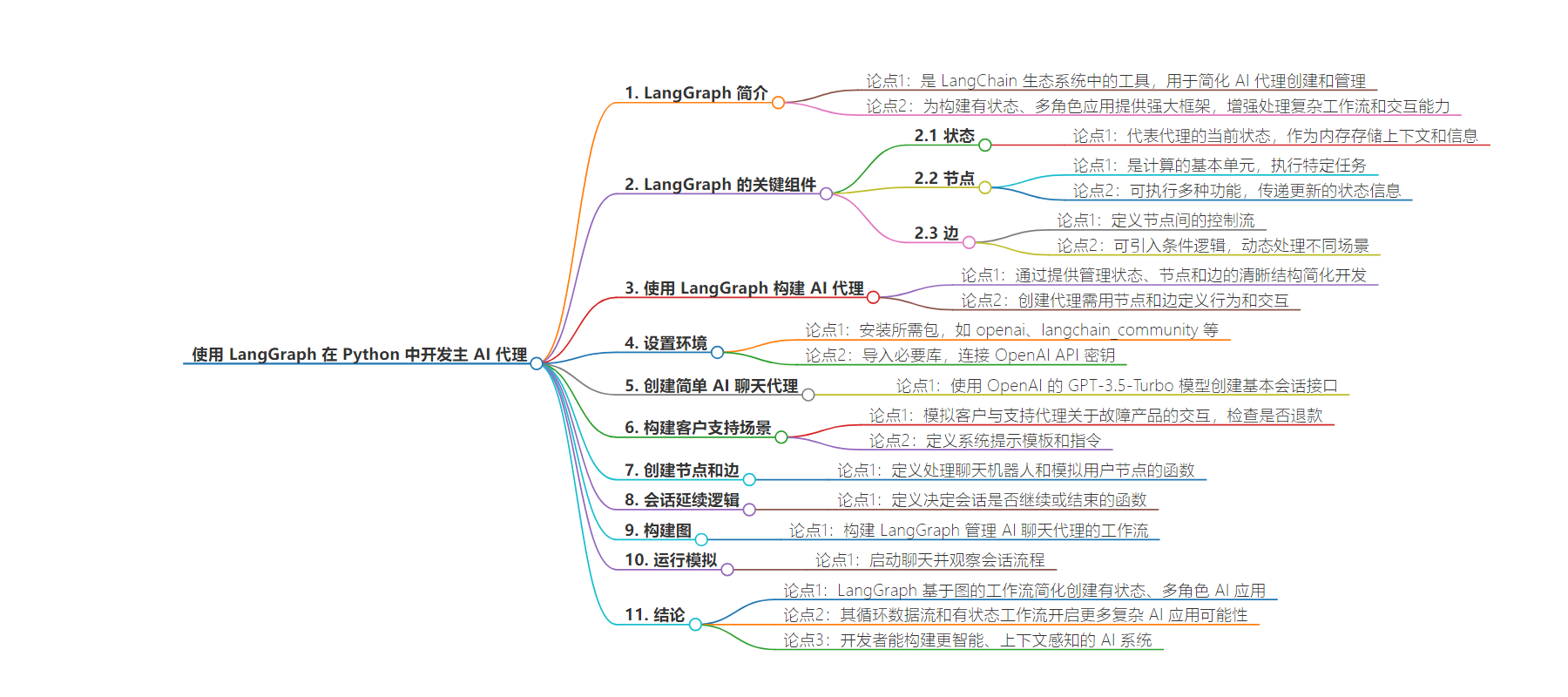包阅导读总结
1.
– `LangGraph` 、`Python` 、`AI Agent` 、`State` 、`Node`
2.
LangGraph 是 LangChain 生态系统中的工具,用于创建和管理 AI 代理。本文介绍了其关键组件,包括状态、节点和边,还通过示例讲解如何用它构建 AI 代理,包括设置环境、创建聊天代理、处理客户支持场景等,强调其简化了复杂 AI 应用的创建。
3.
– 介绍 LangGraph
– 是 LangChain 中用于创建和管理 AI 代理的工具
– 能构建有状态、多角色的应用,增强处理复杂工作流和交互的能力
– LangGraph 的关键组件
– 状态:代表代理的当前状态,作为记忆存储信息
– 节点:执行特定任务的基本计算单元
– 边:定义节点间的控制流,引入条件逻辑
– 用 LangGraph 构建 AI 代理
– 提供清晰结构管理状态、节点和边
– 示例包括创建简单聊天代理和客户支持场景
– 需设置环境,安装所需包,导入库并连接 API 密钥
– 结论
– 简化了多角色 AI 应用创建,开启更多可能性
– 开发者能构建更智能、上下文感知的系统
思维导图:
文章地址:https://thenewstack.io/develop-a-master-ai-agent-with-langgraph-in-python/
文章来源:thenewstack.io
作者:Oladimeji Sowole
发布时间:2024/7/22 13:53
语言:英文
总字数:588字
预计阅读时间:3分钟
评分:86分
标签:AI 代理,LangChain,LangGraph,Python,AI 开发
以下为原文内容
本内容来源于用户推荐转载,旨在分享知识与观点,如有侵权请联系删除 联系邮箱 media@ilingban.com
LangGraph is a specialized tool within the LangChain ecosystem designed to streamline the creation and management of AI agents. It offers a robust framework for building stateful, multi-actor applications, enhancing the capabilities of AI systems to handle complex workflows and interactions.
Key Components of LangGraph
- State: The state represents the current status of the agent. It acts as a memory, storing the context and information the agent needs to make decisions and respond appropriately during interactions.
- Node: Nodes are the fundamental units of computation in LangGraph. Each node performs specific tasks, such as processing user input or generating responses. Nodes can execute various functions, including calling APIs or running code, and they pass updated state information to the next node in the workflow.
- Edge: Edges define the control flow between nodes. They direct the sequence of operations by connecting nodes and determining the path data takes through the graph. Edges can introduce conditional logic, enabling the agent to handle different scenarios dynamically.
Building an AI Agent With LangGraph
LangGraph simplifies developing advanced AI applications by providing a clear structure for managing states, nodes and edges. This makes it easier to build intelligent, context-aware agents capable of handling complex interactions.
To create an AI agent, define the agent’s behavior and interactions using nodes and edges. For example, you can make a customer support agent that processes user queries and provides responses using OpenAI’s GPT-3.5-Turbo model. The agent’s state keeps track of the conversation context while nodes execute the necessary computations to generate responses. Edges control the flow of the conversation, ensuring the agent responds appropriately to user input.
This tutorial will guide you through building an AI agent using LangGraph, complete with step-by-step code snippets.
Setting Up the Environment
Before we begin, ensure you have the required packages installed. You can do this by running the following command in your code editor:
!pip install openai langchain_community langchain_openai langgraph
Next, import the necessary libraries and set up your environment by connecting to your OpenAI API key:
Remember to change your_openai_api_key to your actual OpenAI API key.
Creating a Simple AI Chat Agent
Let’s create a basic conversational interface using OpenAI’s GPT-3.5-Turbo model. The following function defines our chat agent:
Building a Customer Support Scenario
In this scenario, we simulate a customer named Olasammy interacting with a support agent about a faulty product he purchased. We will guide the conversation and check whether Olasammy gets a refund.
First, define the system prompt template and instructions:
Creating Nodes and Edges
We will define functions to handle the chatbot and simulate user nodes:
Conversation Continuation Logic
Define a function to decide whether to continue or end the conversation:
Building the Graph
Now, let’s build the LangGraph to manage our AI chat agent’s workflow:
Running the Simulation
Initiate the chat and observe the conversation flow:
Conclusion
LangGraph simplifies the creation of stateful, multi-actor AI applications using graph-based workflows. LangGraph’s cyclic data flows and stateful workflows open up possibilities for more sophisticated AI applications. Feel free to include enhanced conversational experiences, such as iterative interactions, customizable flows and multi-agent collaboration.
With LangGraph, developers can build more intelligent, context-aware AI systems that provide superior user interactions and solutions.
The AI revolution is not a distant future; it’s happening now. Building an AI-ready team is imperative for staying competitive in this new era. Read our blog to find out how.
YOUTUBE.COM/THENEWSTACK
Tech moves fast, don’t miss an episode. Subscribe to our YouTubechannel to stream all our podcasts, interviews, demos, and more.
